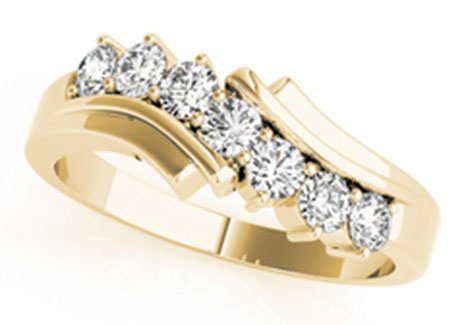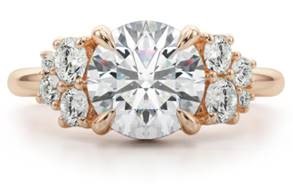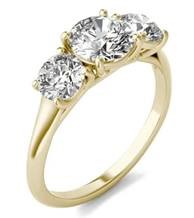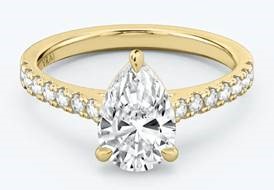Wedding season has a new star
A diamond is still forever, still the principal symbolic gem shining from an engagement ring. But now, in a modern merger of trends and technology, that ring is increasingly likely to have a diamond that was made in a lab.
Engagement ring sales signal the rising acceptance of lab-made diamonds. Last March the number of engagement rings sold with LGDs (lab-grown diamonds) jumped 63% over March sales a year ago, while the sales of rings with mined diamonds fell.
Price is a major factor. LGDs cost substantially less than mined diamond of the same quality—as much as 75% less. For any given price, a consumer can get a much larger diamond if it's lab-made.
For insurers:
- Expect to see more lab-made diamonds this bridal season.
- Be diligent about appraisals and lab reports. Be sure they state whether the diamond is mined or lab-grown.
 Photo courtesy of Yadav Jewelry
Photo courtesy of Yadav Jewelry Just a few years ago many jewelers resisted carrying lab-grown diamonds. Now, catching the wave of the future, they can advertise diamonds that are not only affordable but are "designer" diamonds that are "grown above ground" and "handcrafted."
Signet, the largest jewelry company in the U.S., has expanded its lab-made bridal jewelry selection in Zales and Kay Jewelers in response to customer demand. Pandora will be converting to lab-grown for all its diamond jewelry.
Websites of brand-name jewelry companies often have parallel sections, one for a range of jewelry with mined diamond and another for lab-grown. Each has its appeal, and manufacturers are covering all bases. A survey this year by the luxury jewelry house Jean Dousset found that 75% of shoppers would say yes to purchasing a lab-grown diamond engagement ring, compared to just 36% who gave that answer in 2021.
For insurers:
- Lab-made diamonds proudly take their place in luxury brand-name jewelry, as well as in moderately priced jewelry.
- Jewelry at all price points may carry either mined or lab-made diamonds.
A few years ago most gem-grading labs did not grade lab-grown diamond. Now all the respectable grading labs do. Lightbox, owned by de Beers, originally did not even grade its own lab-grown diamonds because "they are all the same." Now Lightbox, and consumers, know better.
For insurers:
- All lab-grown diamonds are not equal. Lab-made diamonds, like mined diamonds, vary in quality.
- All diamonds of substantial value should have a grading report from a reliable gem-grading laboratory describing their 4 Cs—color, clarity, carat weight and cut. (See below for links to labs.)
- Be sure the report states whether the diamond is mined (sometimes called natural) or lab-made.
Lab-grown diamonds are currently valued from 30% to 70% below that of mined diamonds, so the distinction is crucial. An error here could result in a very costly settlement.
For insurers:
- Be on guard against fraud.
- Lab-grown diamonds may be sold and priced as higher-value mined diamonds. Sales documents may lack information. Most gemologist appraisers do not have the expensive lab equipment needed to recognize lab-made diamond. It's wise to require a grading report from a reliable grading lab.
FOR AGENTS & UNDERWRITERS
Jewelry you insure is increasingly likely to have lab-made diamonds.
Lab-made diamond is worth substantially less than mined diamond—currently as much as 75% less.
Don't assume it's a high-value mined diamond. Be sure to read all the fine print on the appraisal and lab report.
Lab-made, man-made, laboratory-grown, created, cultured and synthetic are terms describing real (not imitation) diamond made in a lab.
As technology improves and the production of lab-grown diamonds increases, their price will go down. At the same time, the supply of diamonds in the earth is limited, so values of mined diamonds may go up. The situation highlights the importance of keeping valuations up to date. This goes for policies already in place as well as for new coverage.
If lab-grown diamond is passed and priced as mined diamond, the appraisal valuation may be grossly inflated.
It's always best to ask for the sales receipt, which will more likely reflect the value of the jewelry. A large discrepancy between purchase price and valuation may indicate a lab-made diamond with mined-diamond valuation.
Distinguishing lab-made diamond from mined diamond is beyond the training or technology of most gemologist appraisers. Only a grading lab with appropriate equipment can reliably make this determination
We recommend the following labs and suggest that you use these links to verify reports you receive.
GIA Report Check
AGS Report Verification
GCAL Certificate Search
The best appraisal includes the JISO 78/79 appraisal form and is written by a qualified gemologist (GG, FGA+, or equivalent), preferably one who has additional insurance appraisal training. One course offering such additional training is the Certified Insurance Appraiser™ (CIA) course of the Jewelry Insurance Appraisal Institute.
FOR ADJUSTERS
Mined diamond has a substantially higher valuation than lab-made diamond. If the appraisal or lab report does not explicitly state whether the gem is mined or lab-grown, use every means possible to determine which it is. If possible, interview the seller!
Deliberate non-disclosure is always possible.
Lab-made, man-made, laboratory-grown, created, cultured and synthetic are terms describing real (not imitation) diamond made in a lab.
Be especially diligent with colored diamonds, which are very expensive for mined diamond but easily produced in the lab. For example, Lightbox (owned by De Beers) sells its pink and blue diamonds at the same price as its colorless diamonds.
Sales receipts and proof-of-payment docs are often helpful in establishing whether a diamond is mined or lab-made. Read the fine print!
Take note of brand names on the docs, as some names may indicate producers or retailers of lab-made stones.
On a damage claim, ALWAYS have the jewelry examined in a gem lab that has reasonable equipment for the job and is operated by a trained gemologist (GG, FGA+ or equivalent), preferably one who has additional insurance appraisal training, such as a Certified Insurance Appraiser™.
©2000-2025, JCRS Inland Marine Solutions, Inc. All Rights Reserved. www.jcrs.com





